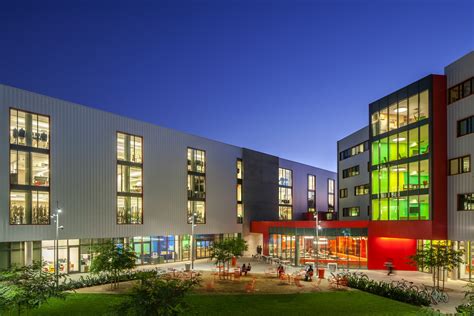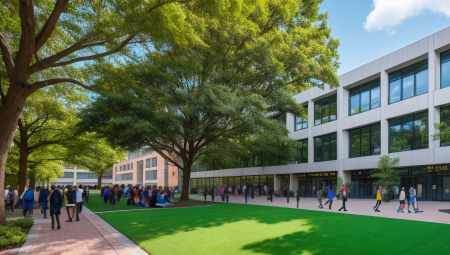In recent years, sustainable design has become an increasingly crucial aspect of the architecture industry. As the world grapples with environmental challenges, the role of architects in creating eco-friendly and energy-efficient spaces has never been more important. This has led to a growing demand for professionals with expertise in sustainable architecture, making it a valuable area of study for aspiring architects.
In this blog post, we will delve into the world of sustainable architecture programs in the top US universities. We will explore the significance of sustainable design in architecture, highlight the top programs with a focus on sustainable design, examine the curriculum of these programs, and shed light on the expertise of faculty members in sustainable architecture. Additionally, we will discuss internship and experiential learning opportunities, as well as showcase case studies of sustainable architectural projects and student organizations promoting sustainability in architecture. Finally, we will touch upon collaboration with environmental science departments, green building certification programs, and career prospects in sustainable architecture. Join us as we uncover the exciting opportunities in the field of sustainable architecture.
Table of Contents
Importance of Sustainable Design in Architecture
With the increasing concerns about the environment and climate change, the importance of sustainable design in architecture cannot be overstated. Architects and designers are now focusing on creating buildings and structures that not only serve the needs of the present generation but also take into account the well-being of future generations. Sustainable design in architecture involves using materials and techniques that minimize the negative impact on the environment, conserve natural resources, and promote energy efficiency.
One of the key reasons why sustainable design in architecture is important is its contribution to reducing carbon footprint and combating climate change. Buildings are responsible for a significant portion of global energy use and greenhouse gas emissions. By embracing sustainable design principles, architects can significantly reduce the energy consumption and carbon emissions of buildings, thus playing a crucial role in the fight against climate change.
In addition to environmental benefits, sustainable design in architecture also offers economic advantages. Although sustainable design may involve higher upfront costs, the long-term benefits in terms of energy savings and reduced maintenance costs make it a financially sound investment. Additionally, sustainable buildings often have higher property values and are more attractive to tenants and buyers, leading to greater returns on investment.
Furthermore, sustainable design in architecture has a positive impact on the health and well-being of the occupants. By incorporating natural light, ventilation, and non-toxic materials, sustainable buildings create healthier and more comfortable indoor environments. This not only enhances the quality of life for the occupants but also reduces healthcare costs associated with indoor air pollution and other environmental hazards.
Top Architecture Programs with Sustainable Design Focus
When it comes to pursuing a career in architecture with a focus on sustainable design, it’s crucial to find a program that prioritizes environmental consciousness and sustainable practices. Luckily, there are several top architecture programs around the world that offer specialized coursework and resources for students interested in sustainable design.
One such program is Harvard Graduate School of Design, which is known for its commitment to sustainable architecture and urban planning. The school offers a range of courses and resources that focus on sustainable design principles, allowing students to gain a deep understanding of environmentally friendly building techniques and materials.
Another top program is the ETH Zurich Department of Architecture, which prides itself on its strong focus on sustainability and ecological design. With a particular emphasis on research and innovation in sustainable architecture, students at ETH Zurich have the opportunity to engage in cutting-edge sustainable design practices and contribute to the field’s advancement.
Similarly, the University of California, Berkeley offers a top architecture program with a sustainable design focus. With a multidisciplinary approach that incorporates environmental science and design principles, students at UC Berkeley have the opportunity to gain a holistic understanding of sustainable architecture and its impact on the environment.
Curriculum of Sustainable Architecture Programs
When considering a program in sustainable architecture, it’s essential to understand the curriculum offered by various institutions. The curriculum typically includes a range of courses that focus on environmental sustainability, energy efficiency, and green building practices. Students can expect to study topics such as sustainable design principles, green construction materials, and sustainable urban planning.
Another important aspect of the curriculum is the integration of technology and innovation in sustainable architecture. Students will have the opportunity to learn about the latest advancements in building systems, renewable energy sources, and sustainable infrastructure. This hands-on approach allows students to develop practical skills that are essential for success in the field.
Furthermore, a strong focus on research and critical thinking is often emphasized in the curriculum of sustainable architecture programs. Students are encouraged to explore complex environmental challenges and propose innovative solutions through their coursework. This interdisciplinary approach equips students with the knowledge and skills needed to address real-world sustainability issues.
In addition to the core curriculum, students may have the option to pursue specialized tracks or concentrations within the program. These tracks could include areas such as sustainable site design, green building certification, or sustainable community development. This allows students to tailor their education to align with their specific career goals and interests.
Faculty Expertise in Sustainable Architecture
When it comes to pursuing a degree in sustainable architecture, it’s essential to consider the faculty expertise at the institutions you’re considering. The expertise of the faculty can greatly impact the quality of education and the depth of knowledge you’ll gain in sustainable design principles and practices.
Many institutions have faculty members with extensive experience and expertise in sustainable architecture. These experts often have backgrounds in environmental design, green building technology, and sustainable urban planning. Their knowledge and experience can provide valuable insights into the latest trends and best practices in sustainable architecture.
Furthermore, having faculty members with expertise in sustainable architecture can also open up opportunities for collaborative research projects and mentorship. Students can benefit from the guidance and mentorship of faculty members who are actively engaged in research and practice within the field of sustainable design.
Overall, having faculty members with expertise in sustainable architecture is crucial for providing students with a well-rounded and comprehensive education in sustainable design principles and practices.
Internship and Experiential Learning Opportunities
Internship and experiential learning opportunities are an integral part of the education of future architects. Securing an internship allows students to gain practical experience in a professional setting, apply their knowledge to real-world projects, and develop valuable skills that will benefit them in their future careers.
Many architecture programs with a focus on sustainable design offer a variety of internship and experiential learning opportunities for their students. These programs often have partnerships with architectural firms, sustainable design organizations, and other industry professionals, providing students with the chance to work on sustainable projects and learn from leaders in the field.
Participating in internships and experiential learning opportunities also allows students to explore different areas within sustainable architecture, such as green building practices, renewable energy systems, and sustainable materials. This hands-on experience not only enhances their understanding of sustainable design principles but also helps them build a strong portfolio of work to showcase to potential employers.
Furthermore, these opportunities can lead to valuable networking connections and potential job offers upon graduation, making them an essential component of a comprehensive sustainable architecture education.
Case Studies of Sustainable Architectural Projects
One case study of a sustainable architectural project is the Bullitt Center in Seattle, Washington. This six-story office building is designed to be net-zero energy and water, as well as carbon-neutral. The building includes features such as a large rooftop solar array, a rainwater harvesting system, and composting toilets, all of which contribute to its sustainability. Another case study is the Bosco Verticale in Milan, Italy. This pair of residential towers is covered in plants and trees, which not only provide green space in a dense urban area but also help to lower the surrounding temperature and improve air quality. These case studies demonstrate how sustainable design can be incorporated into large-scale architectural projects, creating buildings that are environmentally friendly and beneficial to their surroundings.
Another case study is the CopenHill power plant in Copenhagen, Denmark. This facility not only generates energy from waste but also includes a ski slope and hiking trail on its roof, turning a traditionally industrial structure into a recreational and sustainable space. The Waterbank School in Kenya is also a noteworthy case study of sustainable architecture. This innovative school was designed to collect and store rainwater, provide natural ventilation, and have a minimal environmental impact. The design of this school demonstrates how sustainable architecture can address the specific needs of different communities while also being aesthetically pleasing.
These case studies highlight the diverse approaches to sustainable architectural projects around the world, showing how innovative design and technology can be used to create buildings that are both environmentally conscious and functional. By studying these case studies, architects and students can gain valuable insights into the possibilities and challenges of sustainable architecture, inspiring them to develop their own innovative solutions for future projects.
Overall, the case studies of sustainable architectural projects serve as compelling examples of the positive impact that sustainable design can have on the built environment. These projects not only showcase the potential for energy efficiency, resource conservation, and improved quality of life but also demonstrate the importance of considering the broader ecological and social implications of architectural design.
Student Organizations Promoting Sustainability in Architecture
Student organizations dedicated to promoting sustainability in architecture play a crucial role in shaping the future of the industry. These organizations provide a platform for students to engage in activities that promote environmentally friendly practices within the field of architecture. By raising awareness and organizing events, these groups are able to foster a culture of sustainability among the future leaders of the profession.
One of the key benefits of joining a student organization focused on sustainability in architecture is the opportunity for networking and collaboration. Members have the chance to connect with like-minded individuals who share a passion for sustainable design, creating a community of support and inspiration. These connections often extend beyond the university setting and can lead to valuable professional relationships in the future.
Additionally, student organizations promoting sustainability in architecture often provide educational opportunities for members. This can include workshops, lectures, and seminars that delve into the latest trends and developments in sustainable design. By staying informed and engaged, students are better equipped to incorporate sustainable principles into their academic work and future professional endeavors.
Finally, these organizations serve as a platform for advocacy and activism within the architectural community. By collaborating on initiatives and projects, students can make a tangible impact on campus and in the broader industry. Whether it’s advocating for sustainable building practices or campaigning for greener campus policies, these groups empower students to become active agents of change.
Collaboration with Environmental Science Departments
Collaboration with Environmental Science Departments is vital for sustainable architecture programs. By partnering with environmental science departments, architecture programs can gain valuable insights and expertise in areas such as ecology, climate change, and renewable energy. This collaboration allows students and faculty to work alongside scientists and researchers to develop innovative solutions for sustainable design.
Furthermore, collaboration with environmental science departments provides students with interdisciplinary learning opportunities. They can engage in projects that integrate principles of architecture and environmental science, gaining a deeper understanding of the relationship between built environments and the natural world. This type of hands-on experience prepares students to address complex sustainability challenges in their future careers.
In addition, collaboration with environmental science departments fosters a culture of cross-disciplinary collaboration within the academic community. It promotes knowledge exchange between different fields and encourages holistic approaches to sustainable design. By working together, students and faculty can explore new ideas and push the boundaries of what is possible in sustainable architecture.
Overall, collaboration with environmental science departments enriches the educational experience of architecture students and enhances the research capabilities of faculty. It is an essential component of a comprehensive sustainable architecture program, allowing for the integration of scientific insights and innovative design practices.
Green Building Certification Programs
Green building certification programs are becoming increasingly important in the field of architecture and construction. These programs are designed to ensure that buildings are constructed and operated in an environmentally sustainable manner, with a focus on energy efficiency, water conservation, and overall environmental impact.
One of the most well-known green building certification programs is the Leadership in Energy and Environmental Design (LEED) certification, which is administered by the U.S. Green Building Council. This program provides a framework for identifying and implementing practical and measurable green building design, construction, operations and maintenance solutions.
Another prominent green building certification program is the Building Research Establishment Environmental Assessment Method (BREEAM), which is widely used in the United Kingdom and Europe. BREEAM sets the standard for best practice in sustainable building design, construction and operation and has become one of the most comprehensive and widely recognized measures of a building’s environmental performance.
As the demand for environmentally friendly buildings continues to grow, the importance of green building certification programs cannot be overstated. These programs not only help architects and construction professionals stay current with the latest sustainable design practices, but also provide a means for clients and stakeholders to evaluate the environmental performance of a building.
Career Prospects in Sustainable Architecture
As the demand for sustainable design and construction continues to grow, the career prospects in sustainable architecture are also on the rise. With a growing emphasis on environmental consciousness and green building practices, there is an increasing need for professionals who specialize in sustainable architecture.
Professionals with expertise in sustainable architecture can find opportunities in a variety of fields, including architectural firms, construction companies, government agencies, and non-profit organizations. They may work as sustainable design architects, green building consultants, environmental planners, or project managers, among other roles.
Individuals pursuing a career in sustainable architecture can expect to contribute to the development of environmentally-friendly buildings and structures, as well as play a key role in promoting sustainable practices within the industry. They may also have opportunities to collaborate with other professionals in the fields of engineering, environmental science, and urban planning to create innovative and eco-friendly designs.
Furthermore, the growing demand for sustainable architecture has led to an increase in the number of job opportunities in the field. According to the Bureau of Labor Statistics, the employment of architects is projected to grow 8 percent from 2018 to 2028, with a focus on sustainable design and construction contributing to this growth.





